Supplementary data: Nova Scotia
This page provides data visualizations related to the priorities for Canada’s cancer system.
The data tables and technical appendix for all indicators are available upon request at info@partnershipagainstcancer.ca.
Priority 1 Action 1: Help people to stop smoking or not start in the first place and live healthier lives
Topic: Keeping people smoke-free
Title of image: Percentage of individuals in NS (aged ≥ 12) classified as daily or occasional smokers
Caveats/limitations:
- This indicator was reported using the Canadian Community Health Survey (CCHS).
- Individuals who did not respond to the required CCHS questions regarding smoking status were not included in the analysis.
- The COVID-19 pandemic had major impacts on the data collection operations and response rates for this survey.
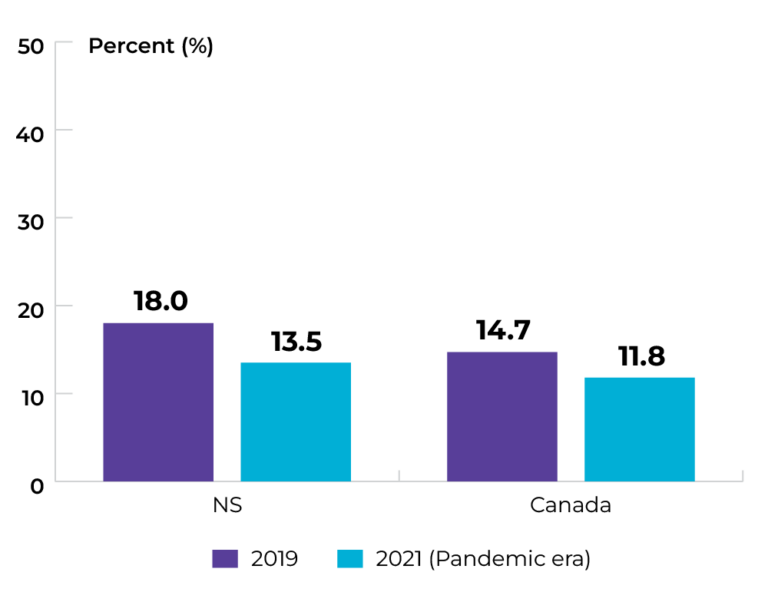 Data source: Canadian Community Health Survey
Data source: Canadian Community Health Survey
Topic: Keeping people smoke-free
Title of image: Percentage of individuals in NS (aged ≥ 18) classified as daily or occasional smokers in 2019, by household income quintile and sex
Caveats/limitations: The COVID-19 pandemic had major impacts on the data collection operations and response rates for this survey.
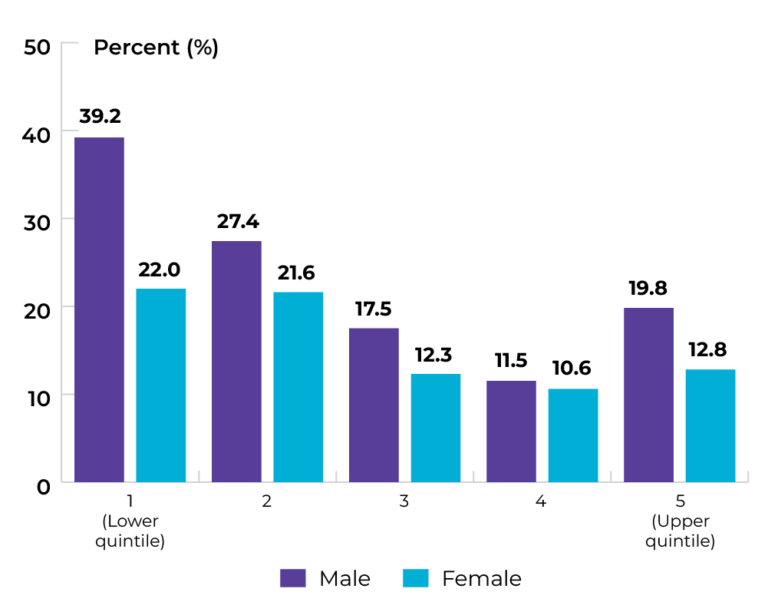
Data source: Canadian Community Health Survey
Topic: Keeping people smoke-free
Title of image: Percentage of individuals in NS (aged ≥ 18) classified as daily or occasional smokers in 2019, by highest level of education
Caveats/limitations: The COVID-19 pandemic had major impacts on the data collection operations and response rates for this survey.
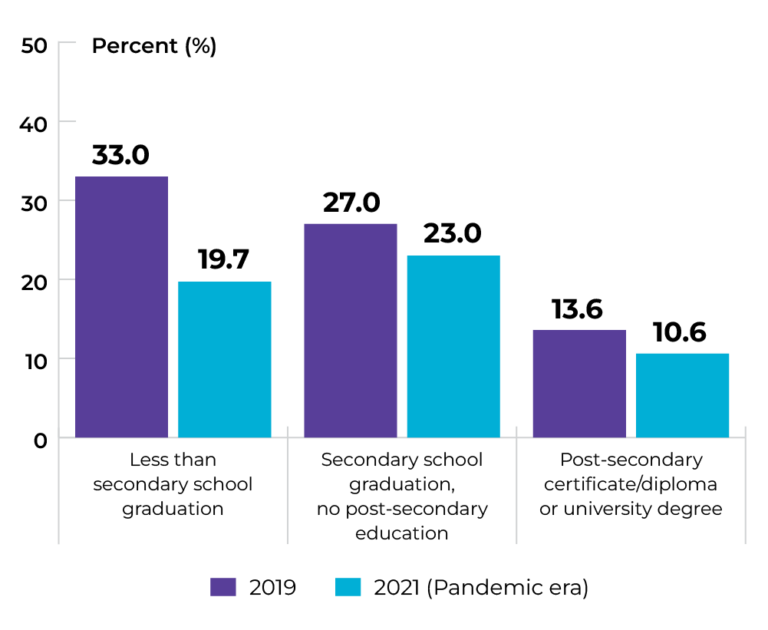
Data source: Canadian Community Health Survey
Topic: Maintaining healthy body weight
Title of image: Percentage of individuals in NS (aged ≥ 18) classified as overweight or obese
Caveats/limitations:
- This indicator was reported using the Canadian Community Health Survey (CCHS).
- Individuals who did not respond to the required CCHS questions to derive the BMI classifications were not included in the analysis.
- The COVID-19 pandemic had major impacts on the data collection operations and response rates for this survey.
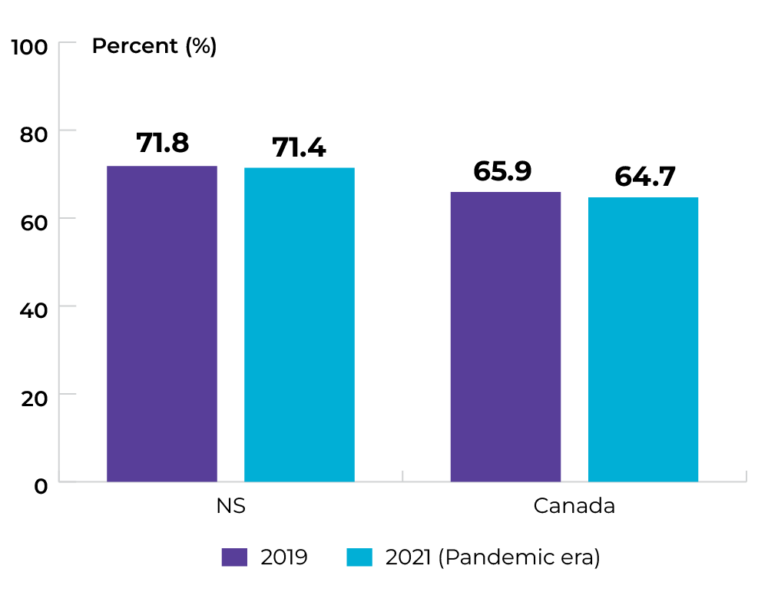 Data source: Canadian Community Health Survey
Data source: Canadian Community Health Survey
Topic: Maintaining healthy body weight
Title of image: Percentage of individuals in NS (aged ≥ 18) classified as overweight or obese, by sex
Caveats/limitations: The COVID-19 pandemic had major impacts on the data collection operations and response rates for this survey.
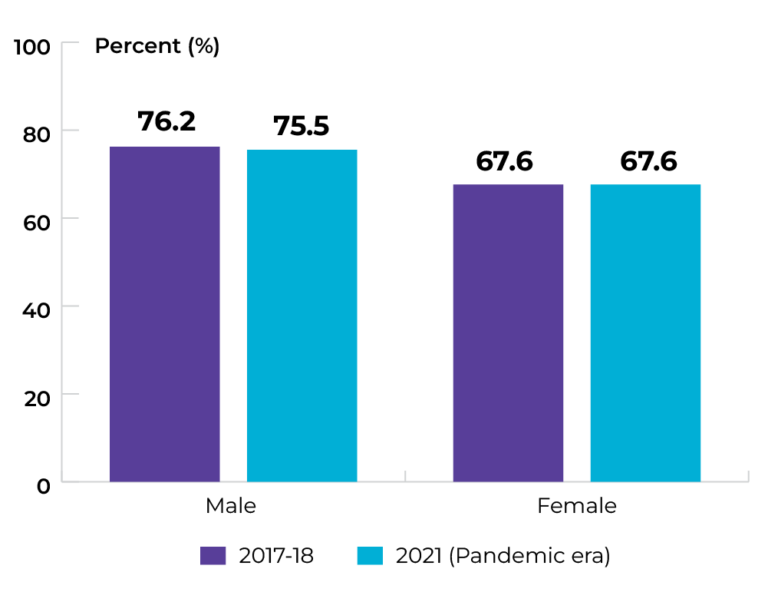 Data source: Canadian Community Health Survey
Data source: Canadian Community Health Survey
Topic: Maintaining healthy body weight
Title of image: Percentage of males in NS (aged ≥ 18) classified as overweight or obese, by income quintile
Caveats/limitations: The COVID-19 pandemic had major impacts on the data collection operations and response rates for this survey.
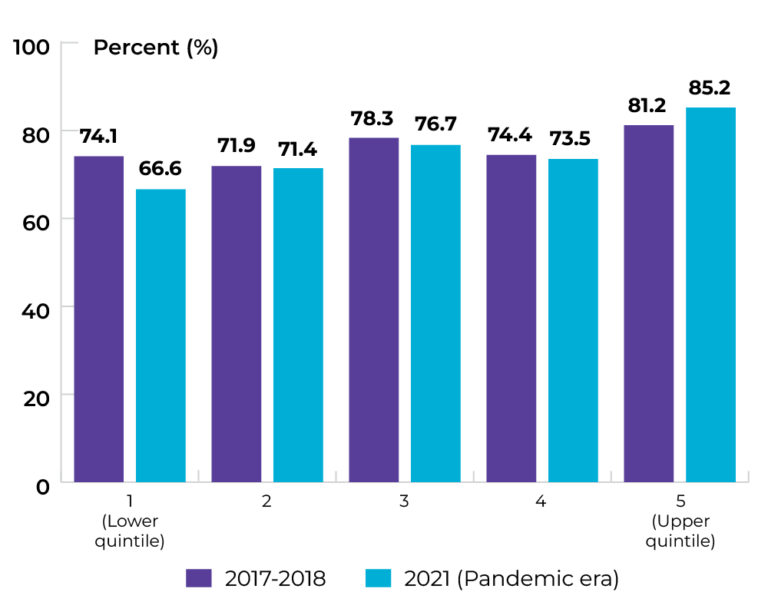
Data source: Canadian Community Health Survey
Topic: Maintaining healthy body weight
Title of image: Percentage of females in NS (aged ≥ 18) classified as overweight or obese, by income quintile
Caveats/limitations: The COVID-19 pandemic had major impacts on the data collection operations and response rates for this survey.
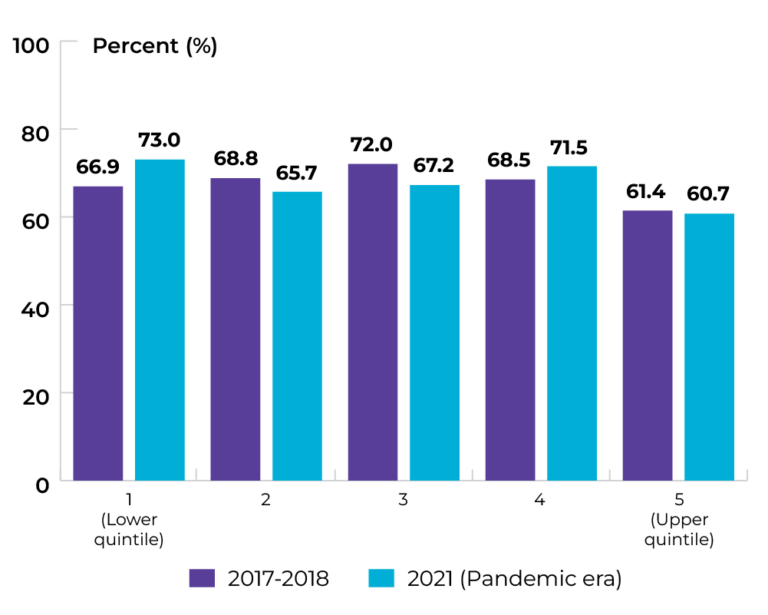
Data source: Canadian Community Health Survey
Priority 1 Action 2: Adopt proven practices known to reduce the risk of cancer
Topic: Increasing HPV vaccination
Title of image: Percentage of Grade 7 students in NS who completed 2 doses of HPV vaccination in Grade 7 or by December 31st of Grade 8 year
Caveats/limitations:
- Additional catch-up efforts have been implemented due to disruptions of COVID-19 on school immunization programs. Catch-up vaccines outside of the school programs are not reflected in the data.
- The COVID-19 pandemic may have affected service provision.

Data source: Provincial cancer agencies and programs
Topic: Increasing HPV vaccination
Title of image: Percentage of Grade 7 students in NS who completed 2 doses of HPV vaccination in Grade 7 or by December 31st of Grade 8 year, by sex
Caveats/limitations:
- “Unknown sex” were included in the total but not in the sex stratification.
- The COVID-19 pandemic may have affected service provision.

Data source: Provincial cancer agencies and programs
Topic: Increasing genetic testing
Title of image: Percentage of individuals in Nova Scotia with a diagnosis of ovarian cancer referred to genetic testing
Caveats/limitations: Cannot differentiate between epithelial and non-epithelial cancer types; therefore would not expect 100% of patients to be referred to genetic testing.

Data source: Provincial cancer agencies and programs
Topic: Increasing genetic testing
Title of image: Percentage of individuals in Nova Scotia diagnosed with ovarian cancer between 2017-19 who were referred to genetic testing, by age
Caveats/limitations: Cannot differentiate between epithelial and non-epithelial cancer types; therefore would not expect 100% of patients to be referred to genetic testing.

Data source: Provincial cancer agencies and programs
Priority 2 Action 1: Prioritize rapid access to appropriate diagnosis for those suspected of having cancer
Topic: Reducing wait for diagnosis
Title of image: Percent of Nova Scotians who had a colonoscopy within 8 weeks of a positive FIT test
Caveats/limitations:
- Data only includes positive FIT tests with a corresponding colonoscopy.
- Data for 2023 is for January – June only.
- An uptick in 2023 is likely due to this time period coinciding with the October 2022 opening of a new endoscopy room dedicated to FIT+ screening and an 8-month period of low positivity rates from the new analyzer.
- The COVID-19 pandemic may have affected service provision.

Data source: Provincial cancer agencies and programs
Topic: Diagnosing cancer earlier
Title of image: Proportion* of stage 4 diagnosis in NS in 2019
*Data is projected proportions of stage 4 diagnosis in 2019
Caveats/limitations: 2019 Cancer Registry data is not currently available. Data presented is based on projections of total case counts and proportions of stage IV diagnoses for colon and lung cancer 2019 and 2018-2019 projected proportion for bladder and melanoma.
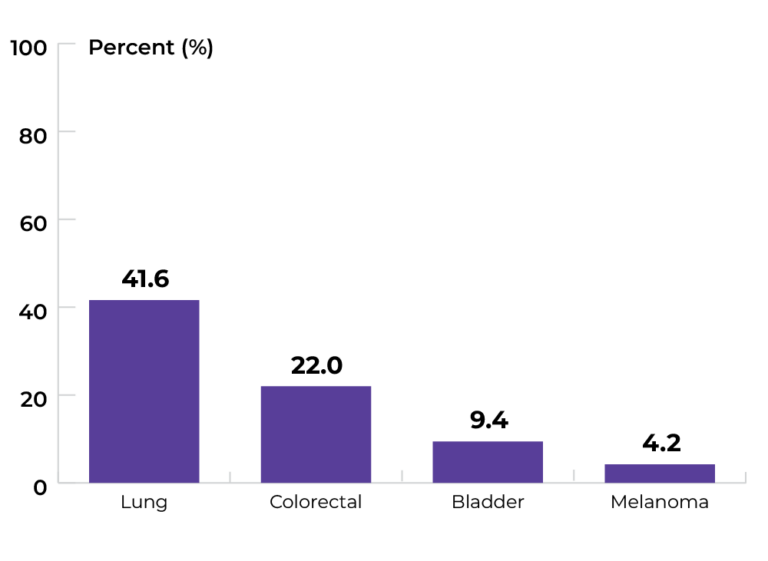 Data source: Provincial cancer agencies and programs
Data source: Provincial cancer agencies and programs
Priority 2 Action 2: Strengthen existing screening efforts and implement lung cancer screening programs across the country
Topic: Increasing participation in colorectal cancer screening
Title of image: Percent of NS residents (50-74 years old) who had a FIT test result, by 24-month screening cycle.
Caveats/limitations:
- The COVID-19 pandemic may have affected service provision.
- Mailing of FIT tests was paused for 7 months in 2020 due to the COVID-19 pandemic.

Data source: Provincial cancer agencies and programs
Topic: Increasing participation in colorectal cancer screening
Title of image: Percent of NS residents (50-74 years old) who had a FIT test resulted by 24-month screening cycle in 2021-23, by sex
Caveats/limitations: The COVID-19 pandemic may have affected service provision.

Data source: Provincial cancer agencies and programs
Topic: Increasing participating in colorectal cancer screening
Title of image: Percent of NS residents (50-74 years old) who had a FIT test resulted by 24-month screening cycle and age
Caveats/limitations: The COVID-19 pandemic may have affected service provision.

Title of table: Percent of NS residents (50-74 years old) who had a FIT test resulted by 24-month screening cycle, by age
| Age group | 2017-19 | 2019-21 (Pandemic era) |
2021-23 |
|---|---|---|---|
| 50-54 | 27.0% | 24.2% | 36.7% |
| 55-59 | 20.9% | 17.4% | 26.7% |
| 60-64 | 36.8% | 29.5% | 43.0% |
| 65-69 | 30.6% | 24.0% | 35.1% |
| 70-74 | 47.0% | 36.3% | 53.7% |
Priority 3 Action 1: Set best practices and standards for care delivery and promote their adoption
Topic: Implementing multidisciplinary care
Title of image: Percentage of pediatric new oncology cases with documented multidisciplinary tumour board rounds prior to initiation of treatment in 2019-2020
Caveats/limitations:
- This includes only documented rounds found in patient charts that contained a list of attendees with 3 or more disciplines documented in attendance
- Data includes pediatric patients from the Maritime provinces seen at the pediatric tertiary centre (IWK Health Centre)
- We suspect the data underestimates multidisciplinary participation in these rounds due to the reliance on chart documentation to capture the data.
- The COVID-19 pandemic may have affected service provision.
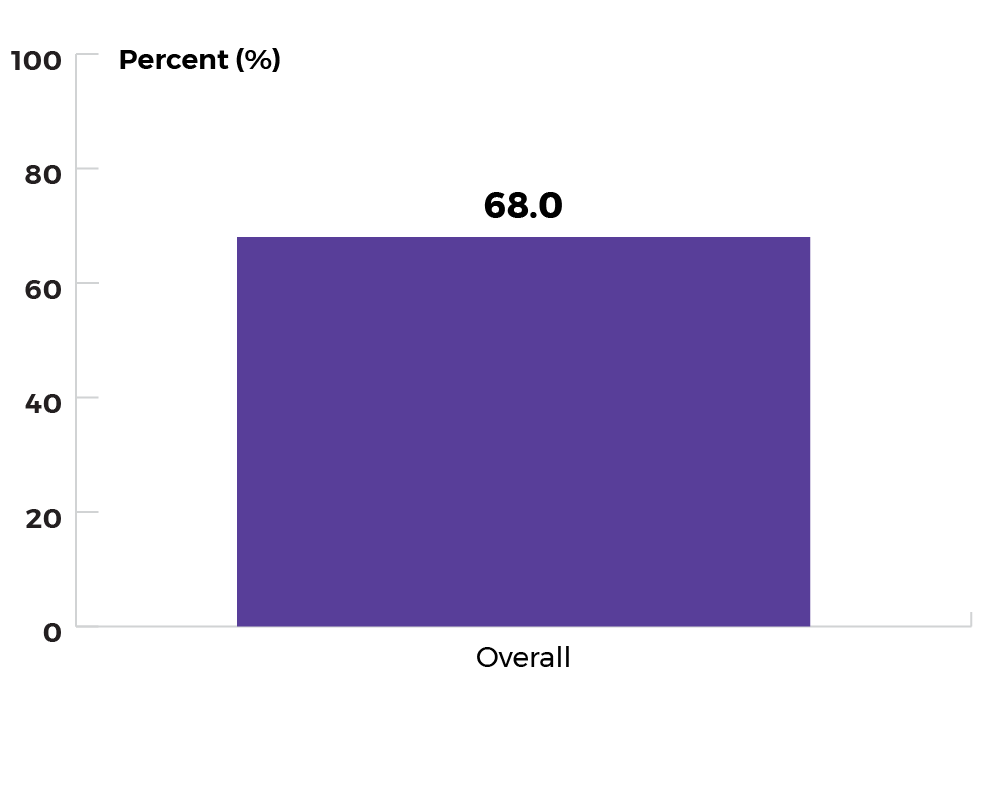 Data source: Provincial cancer agencies and programs
Data source: Provincial cancer agencies and programs
Priority 3 Action 2: Eliminate low-benefit practices and adopt high-value practices
Topic: Optimizing care at end of life
Title of image: Percentage of patients with cancer who received chemotherapy in last two weeks of life
Caveats/limitations:
- The denominator includes only cancer patients who have a history of IV Chemotherapy in their last year of life.
- Hematological cancers are not included in the data.
- Unable to report on oral chemotherapy.
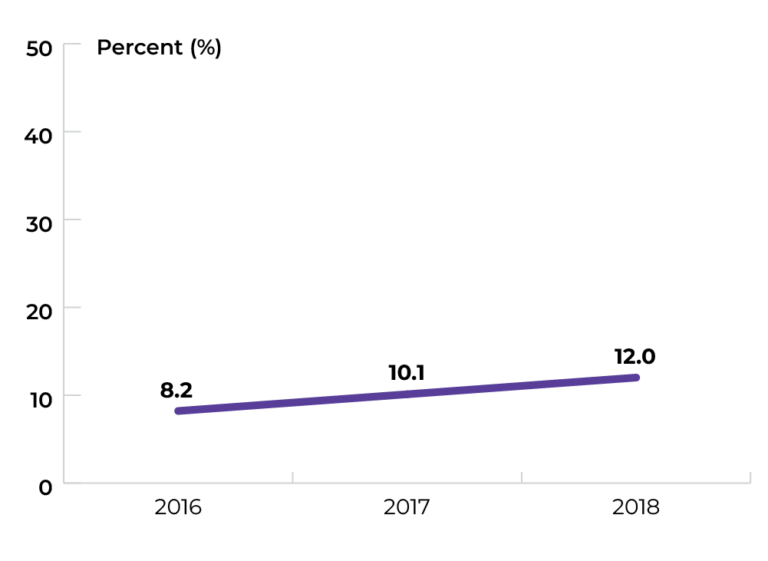
Data sources: Provincial cancer agencies and programs
Topic: Optimizing screening and appropriate follow-up
Title of image: Percentage of people with a cervix in NS aged 18-24 who received a Pap smear, by calendar year and age group
Caveats/limitations:
- Pap smear guidelines changed in Nova Scotia in February 2019. Prior to 2019, screening was recommended for individuals 21 years and older. Therefore, in 2018, individuals aged 21–24 years were screened as per recommended age guidelines at that time.
- People with a cervix may receive a Pap test for symptomatic/diagnostic reasons and therefore we would not expect the percentage to be zero.
- Data is not hysterectomy cleared. Therefore, those who had a hysterectomy and no longer eligible for PAP smear, have not been removed from the denominator.
- The COVID-19 pandemic may have affected service provision.
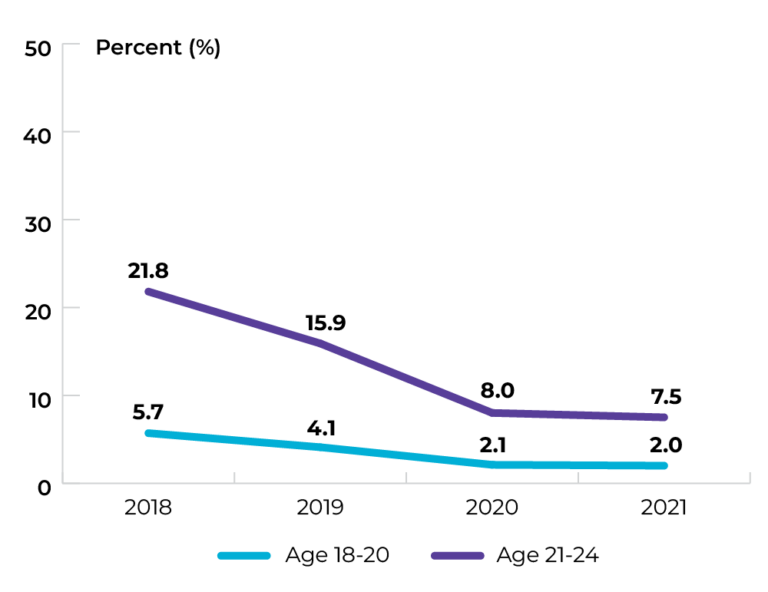
Data source: Provincial cancer agencies and programs
Priority 4 Action 1: Provide better services and care adapted to the specific needs of underserved groups
Topic: Increasing access to culturally safe care
Title of image: Percentage of individuals who indicated “Agreed” or “Strongly Agreed” in response to the 5-point Likert scale questions in 2020
Caveats/limitations:
- The survey was provided only in English and therefore people whose primary language is not English may be underrepresented in the survey. This may have impacted the results of some of the questions.
- The COVID-19 pandemic may have affected service provision.
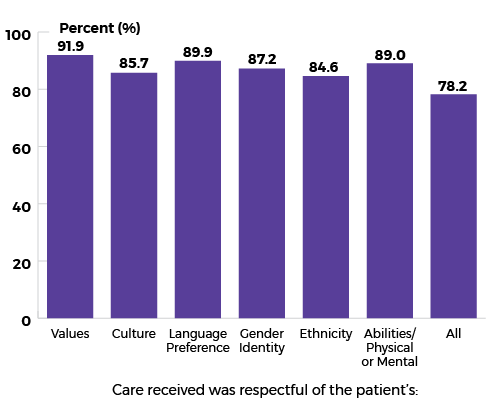 Data source: The Nova Scotia Health Cancer Care Program 2020 Patient Satisfaction Survey
Data source: The Nova Scotia Health Cancer Care Program 2020 Patient Satisfaction Survey
Topic: Increasing support to help patients navigate the system
Title of image: Percent of patients who had at least one visit with a cancer patient navigator within one year of their referral to a cancer centre specialist
Caveats/limitations:
- Navigation data from the Central Health Zone of Nova Scotia is not available prior to 2023.
- The COVID-19 pandemic may have affected service provision.
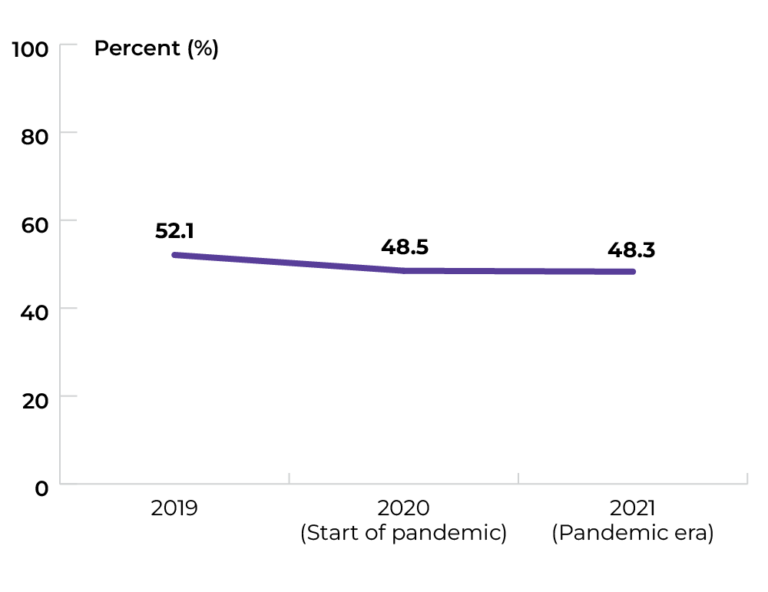
Data source: Provincial cancer agencies and programs
Topic: Increasing support to help patients navigate the system
Title of image: Percent of patients who had at least one visit with a cancer patient navigator within one year of their referral to a cancer centre, by age group
Caveats/limitations:
- Navigation data from the Central Health Zone of Nova Scotia is not available prior to 2023.
- The COVID-19 pandemic may have affected service provision.

Data source: Provincial cancer agencies and programs
Topic: Increasing support to help patients navigate the system
Title of image: Percent of patients who had at least one visit with a cancer patient navigator within one year of their referral to a cancer centre, by sex
Caveats/limitations:
- Navigation data from the Central Health Zone of Nova Scotia is not available prior to 2023.
- The COVID-19 pandemic may have affected service provision.
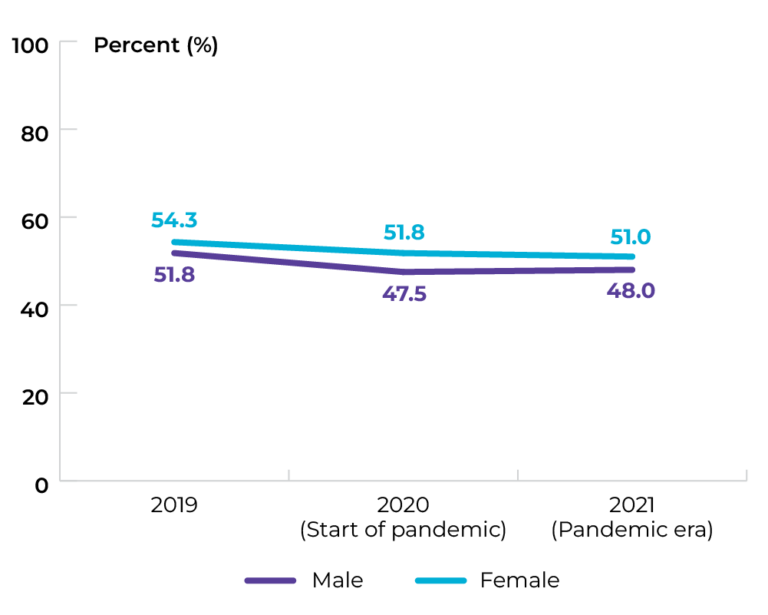
Data source: Provincial cancer agencies and programs
Topic: Increasing support to help patients navigate the system
Title of image: Percent of patients who had at least one visit with a cancer patient navigator within one year of their referral to a cancer centre, by travel time to closest cancer centre
Caveats/limitations:
- Navigation data from the Central Health Zone of Nova Scotia is not available prior to 2023.
- Travel time to closest Cancer Centre is the estimated driving time between the latitude and longitude associated with a resident’s postal code and the latitude and longitude of the two cancer centres (Halifax and Sydney). Travel time is calculated for off-peak driving congestion.
- The COVID-19 pandemic may have affected service provision.
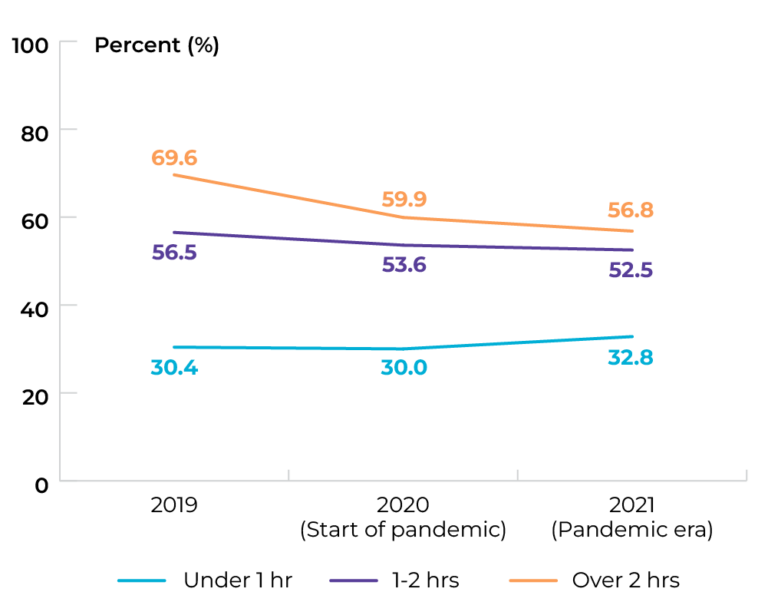
Data source: Provincial cancer agencies and programs
Priority 4 Action 2: Ensure rural and remote communities have the resources required to better serve their people
Topic: Increasing access to virtual care
Title of image: Percentage of cancer patients using virtual health appointments, by number of patients and number of appointments
Caveats/limitations: The COVID-19 pandemic may have affected service provision.
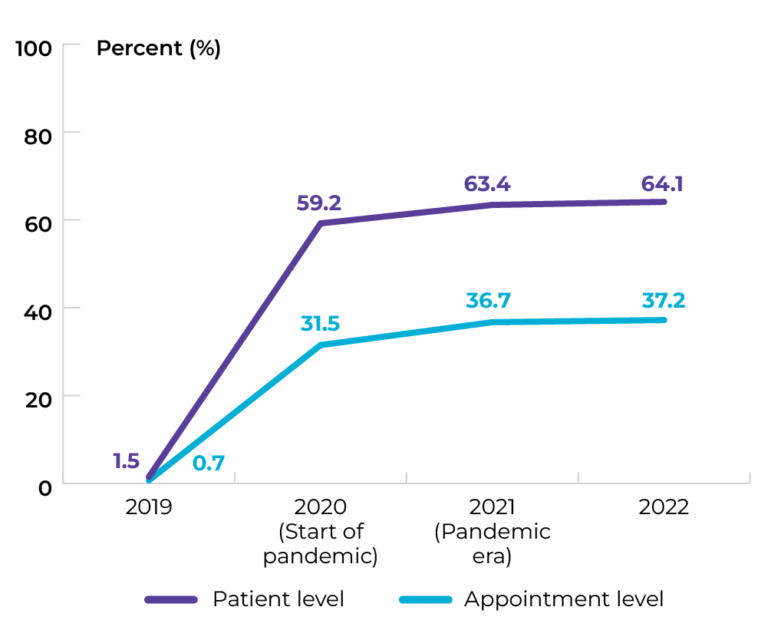
Data source: Provincial cancer agencies and programs
Topic: Increasing access to virtual care
Title of image: Percentage of cancer patients using virtual health appointments, by travel time to closest Cancer Centre
Caveats/limitations:
- Travel time to closest Cancer Centre is the estimated driving time between the latitude and longitude associated with a resident’s postal code and the latitude and longitude of the two cancer centres (Halifax and Sydney). Travel time is calculated for off-peak driving congestion.
- The COVID-19 pandemic may have affected service provision.
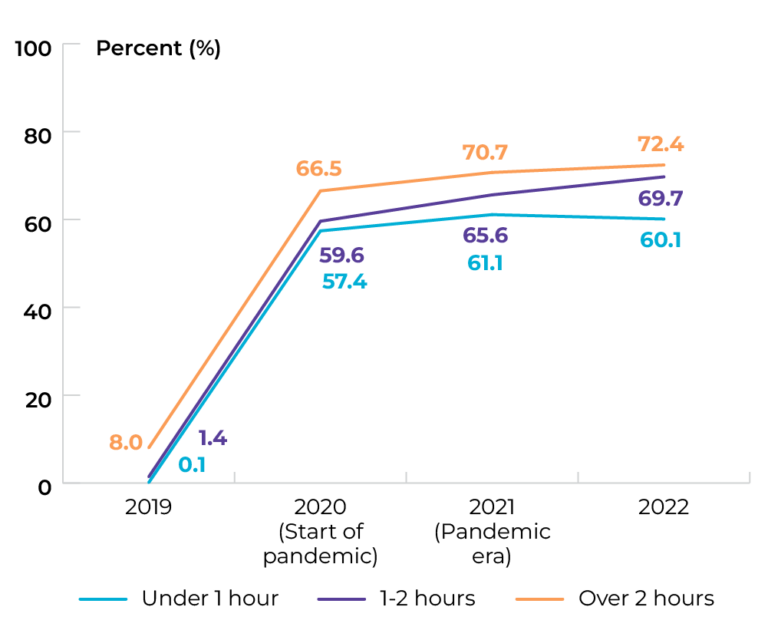
Data source: Provincial cancer agencies and programs
Topic: Increasing access to virtual care
Title of image: Percentage of cancer patients using virtual health appointments, by appointment type
Caveats/limitations: The COVID-19 pandemic may have affected service provision.
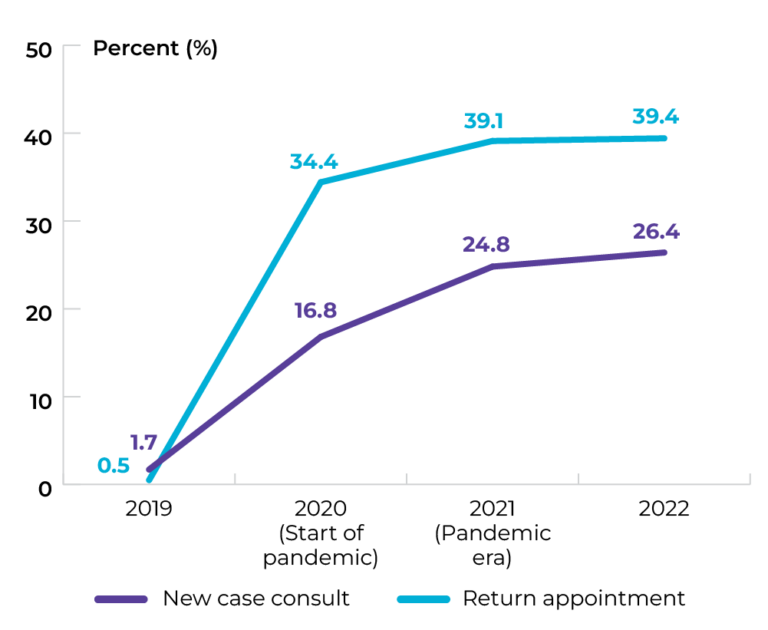
Data source: Provincial cancer agencies and programs
Topic: Increasing access to virtual care
Title of image: Percentage of cancer patients using virtual health appointments, by specialization
Caveats/limitations: The COVID-19 pandemic may have affected service provision.
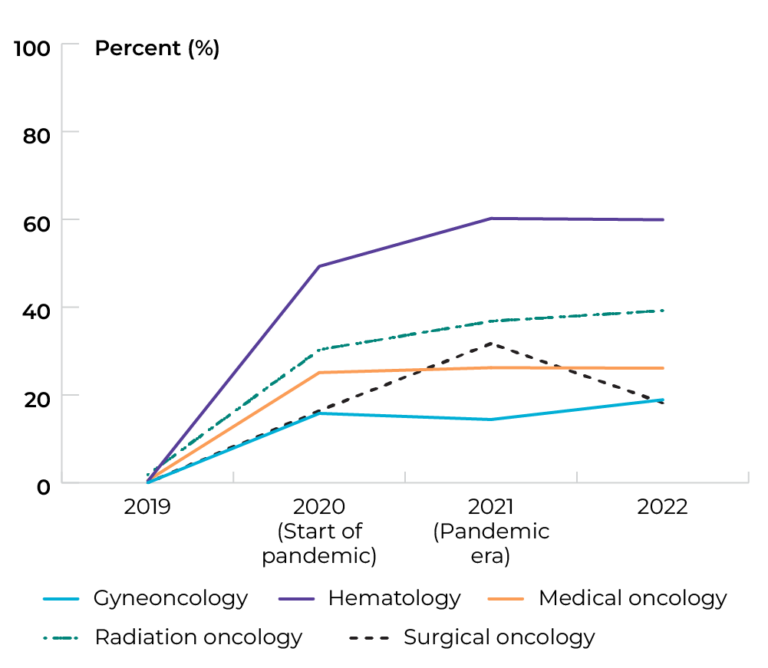
Title of table: Percentage of cancer patients using virtual health appointments, by specialization
| Specialization | 2019 | 2020 (Start of pandemic) | 2021 (Pandemic era) | 2022 |
|---|---|---|---|---|
| Gyneoncology | 0% | 15.8% | 14.4% | 18.9% |
| Hematology | 0.3% | 49.3% | 60.2% | 59.3% |
| Medical oncology | 0.5% | 25.1% | 26.2% | 26.1% |
| Radiation oncology | 1.8% | 30.3% | 36.8% | 39.2% |
| Surgical oncology | 0% | 16.4% | 31.7% | 18.2% |
Data source: Provincial cancer agencies and programs
Topic: Increasing access to supportive psychosocial care services
Title of image: Percentage of individuals who indicated they received supportive help of those who indicated they needed supportive services in 2020
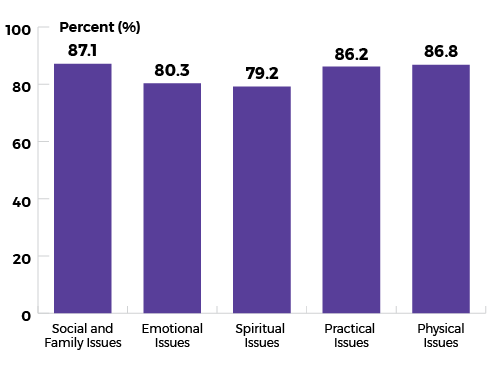
Data source: Nova Scotia Health Cancer Care Program 2020 Patient Satisfaction Survey
Topic: Increasing access to supportive psychosocial care services
Title of image: Percentage of individuals who indicated they received supportive help of those who indicated they needed supportive services in 2020, by geography
Caveats/limitations:
- Respondents who did not need help are not included in the data. The proportion of respondents who did not need help varied by category: 60% did not need help with social and family issues, 55% did not need help with emotional issues, 75% did not need help with spiritual issues, 28% did not need help with physical issues, 66% did not need help with practical issues.
- In Nova Scotia, 50% of cancer patients are considered to reside in rural communities and 50% in urban communities (2014-2018 NS Cancer Registry).
 Data source: Nova Scotia Health Cancer Care Program 2020 Patient Satisfaction Survey
Data source: Nova Scotia Health Cancer Care Program 2020 Patient Satisfaction Survey
Topic: Increasing access to supportive palliative care services
Title of image: Proportion of Nova Scotians (18 yrs and older) who died of cancer related causes and were referred to specialist palliative care services, by geography
Caveats/limitations:
- In Nova Scotia, 50% cancer patients are considered to reside in rural communities and 50% in urban communities (2014-2018 NS Cancer Registry)
- The COVID-19 pandemic may have affected service provision.
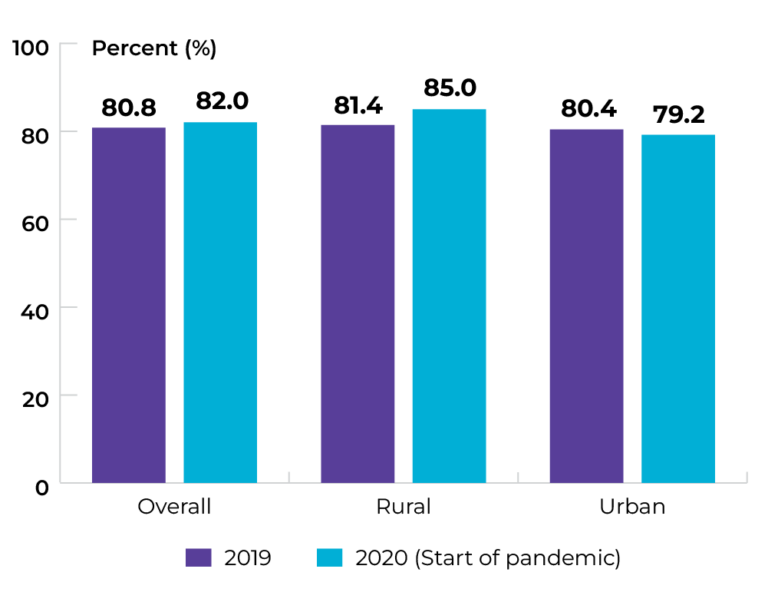
Data source: Provincial cancer agencies and provincial palliative care program
Topic: Increasing access to supportive palliative care services
Title of image: Proportion of Nova Scotians (18 yrs and older) who died of cancer related causes and were referred to specialist palliative care services, by referral timeframe prior to death
Caveats/limitations:
- The 120 and 90 day referral timeframes are not mutually exclusive.
- The COVID-19 pandemic may have affected service provision.
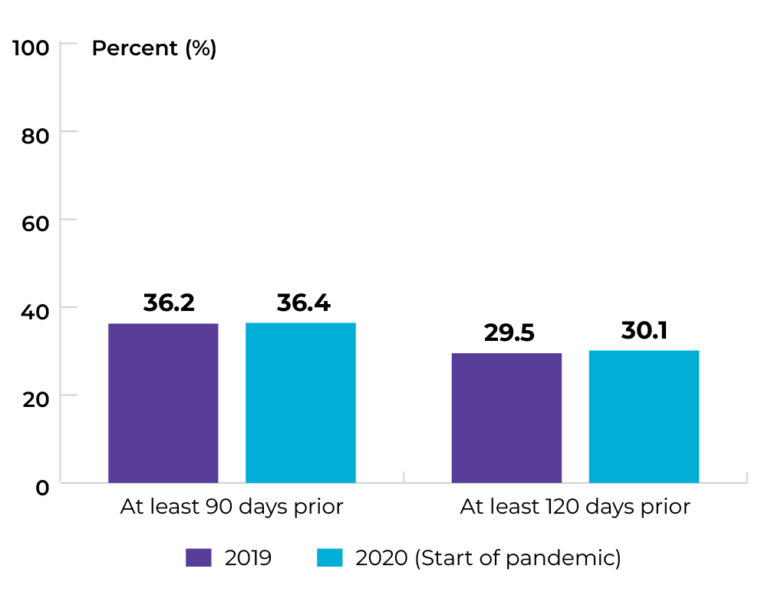 Data source: Nova Scotia Health Cancer Care Program 2020 Patient Satisfaction Survey
Data source: Nova Scotia Health Cancer Care Program 2020 Patient Satisfaction Survey
Priority 5 Action 1: Integrate the full spectrum of information and support services to ensure people are fully supported throughout the cancer experience
Topic: Improving availability of information and support
Title of image: Percentage of cancer patients who reported that they were given enough information about their cancer, its treatments, and the outcome of their cancer in 2020
Caveats/limitations: The COVID-19 pandemic may have affected service provision.
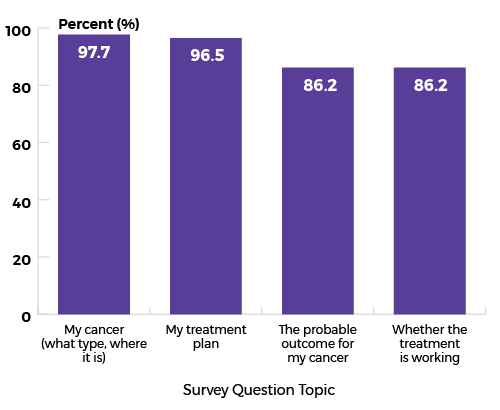 Data source: Nova Scotia Health Cancer Care Program 2020 Patient Satisfaction Survey
Data source: Nova Scotia Health Cancer Care Program 2020 Patient Satisfaction Survey
Priority 5 Action 2: Address the limited and unequal access to palliative and end-of-life care across Canada
Topic: Improving access to quality end-of-life care
Title of image: Place of death for Nova Scotians dying of cancer
Caveats/limitations:
- “Residential facility or home” includes Long Term Care facilities, Residential Care facilities and Continuing Care facilities
- “In hospital” includes acute care and community care hospital units (excluding Palliative Care Units located within the same facility)
- The COVID-19 pandemic may have affected service provision.
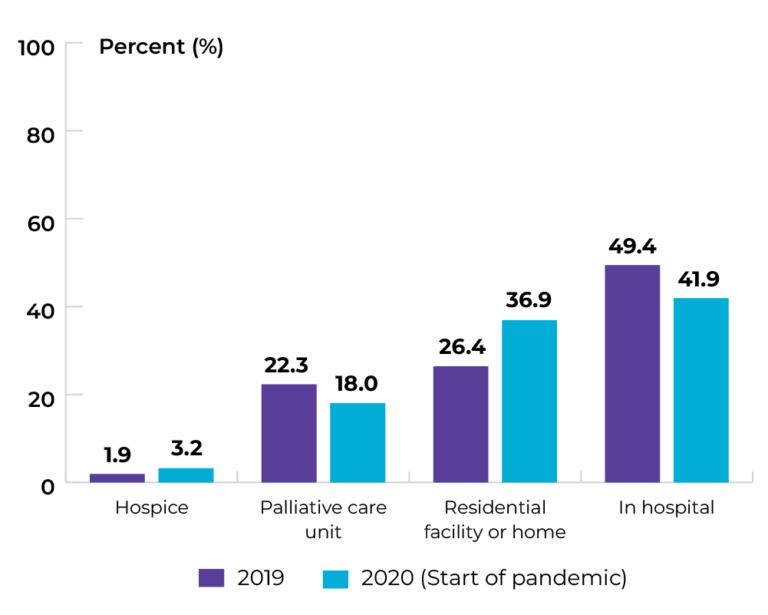
Data source: Provincial cancer agencies and NSH administrative databases
The data tables and technical appendix for all indicators are available upon request at info@partnershipagainstcancer.ca. You will receive a response in two to three business days.
